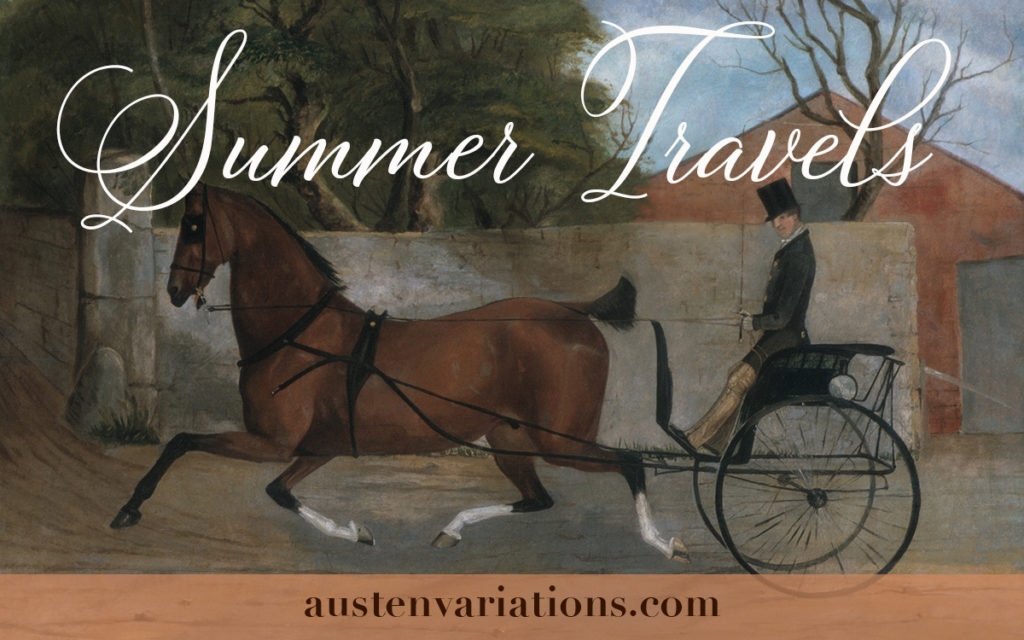
Would you like to have a closer look at the sort of carriages that our favourite characters might have used to travel around town or dash up and down the country?
Then let’s stroll through the Carriage Museum at Arlington Court in North Devon.
There are around 50 vehicles in the collection, the oldest dating back to 1698, but you won’t be surprised to hear that it was the ones from the first half of the 19th century that I lingered around and photographed from every angle.
- State Chariot
- Barouche
- State Coach
- Travelling Chariot with Dormeuse
- Postillion Landau
- Single Brougham
Some have been restored and repainted, others are preserved in their original condition, but they all have one thing in common: these are not gleaming replicas meant as props for period dramas. They’re the real deal. Young ladies in ball gowns have been handed into these carriages. Gentlemen in top hats and greatcoats have travelled along turnpike roads and up and down the cobbled streets of Georgian London in these very vehicles, to deal with affairs of state, look after their interests, spend time with their friends and court their brides-to-be.
The chariot featured below has journeyed even further afield. Mr Gibbs Crawfurd Antrobus of Eaton Hall, Cheshire, used it when he attended the Congress of Vienna (1814-1815) as a junior secretary under Lord Castlereagh. So that’s a round trip of some 2300 miles, and it’s still in excellent condition (no mean feat, given the state of the roads at that time).
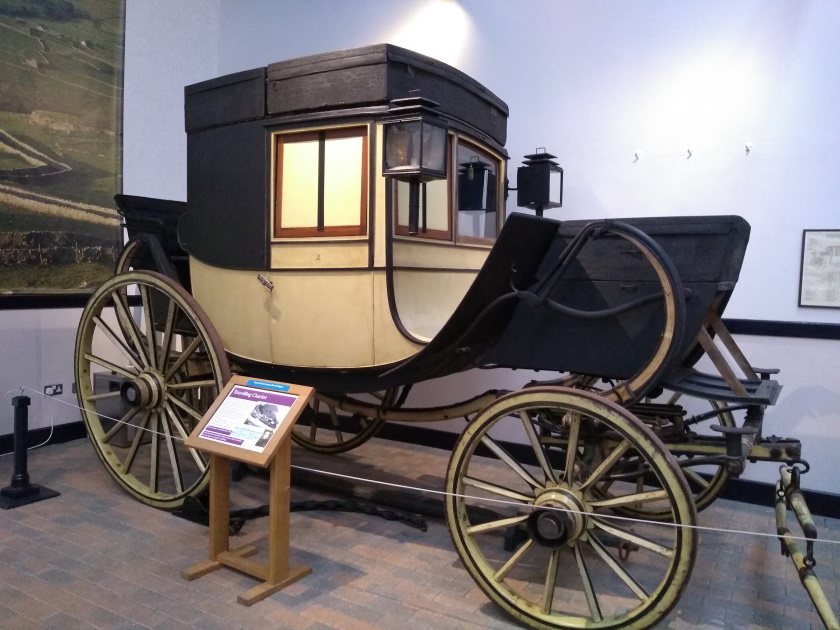
Travelling Chariot
Of all the carriages on display at Arlington Court, I think this is my favourite. I love the connection with the end of the Peninsular War. I love to think that, while this chariot was making its way across Europe, people were reading the recently published Pride and Prejudice. I love the understated coat of arms, which can just about be spotted beneath the window. I can’t help thinking that Mr Darcy’s coat of arms would have been just as discreetly displayed. Lady Catherine, on the other hand, or the likes of Sir Walter Elliot, would have had their coats of arms plastered all over the carriage door and visible from a hundred paces. But what I love the most are the details that clarified a number of points for me.
Whenever I wrote scenes involving travel, all sorts of questions popped to mind. Just how large were the carriages, for instance, and how far off the ground? Could a lively, spirited and impatient young lady leap out without waiting for the step to be lowered? (Actually, yes, at a push, but she’d have to be as active and agile as Elizabeth Bennet 😀 ). How many attendants could be taken along? And last but not least, how on earth did they find enough room for the luggage? After all, one could not be seen wearing the same attire time after time, and Regency gowns and tailcoats would have taken up an awful lot more space than a pile of rolled-up T-shirts. Elizabeth and Maria went to Hunsford with a few small trunks tied to the back of Sir William’s carriage, but what about Mr Darcy, Mr Bingley and the Hursts, who would travel with a couple of footmen in attendance?
I read somewhere that most of the trunks could be sent ahead on waggons in preparation for a lengthy stay in town or when the family returned to the country, but the Antrobus chariot showed me that there were other options: the imperials (wooden suitcases covered in leather and strapped to the roof) and two luggage compartments at the front of the vehicle. The bulge at the back is a sword case.

Travelling Chariot – details
Other models could also offer extra space. If they were postilion-driven, the coachman seat could be flattened, and trunks could be piled up in its place. Some carriages meant for long-distance travel such as the Grand Tour could be equipped with a dormeuse boot (an extension that allowed the occupants to stretch out at full length and sleep while travelling).
You can find out more on the National Trust Carriage Museum website, and if you’d like to have a look at other vehicles in the collection, most of them are available here.
Which one is your favourite?
Have fun exploring, and thanks for reading.
Sources: Information boards at The National Trust Carriage Museum and https://www.nationaltrust.org.uk/arlington-court-and-the-national-trust-carriage-museum/lists/the-national-trust-carriage-museum
Photos: J. Starnes


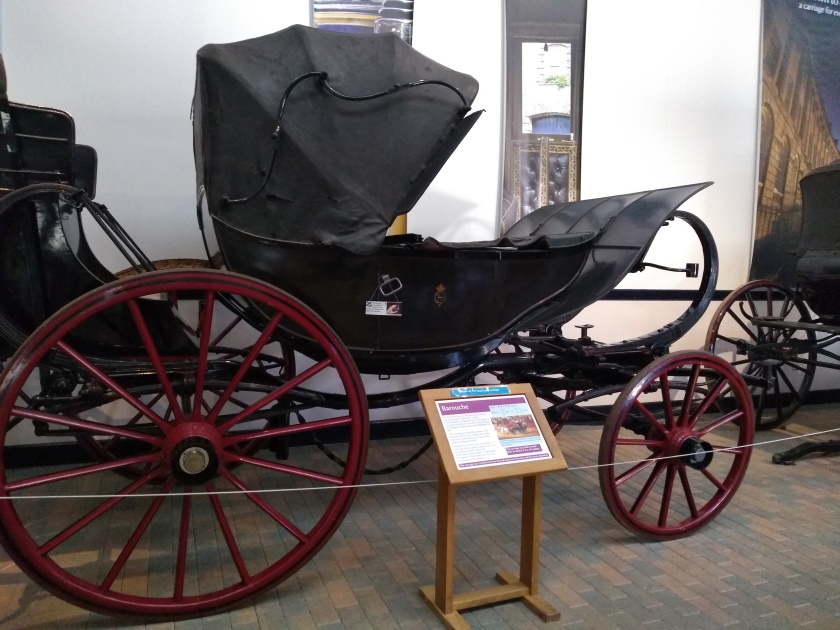

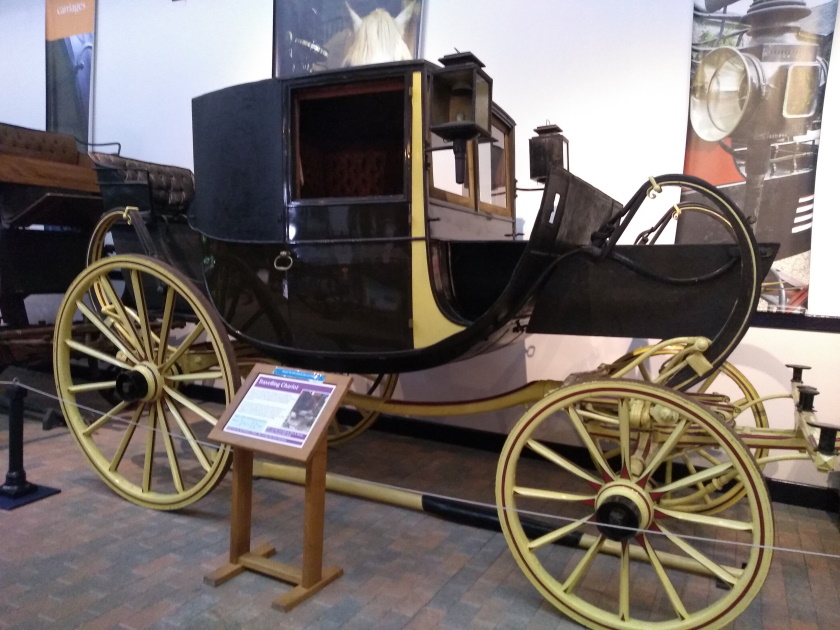

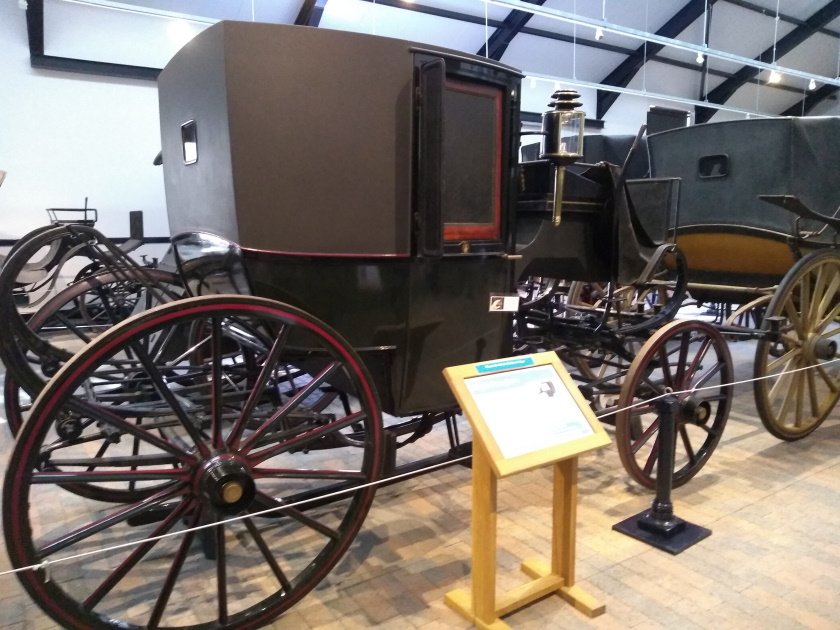
15 comments
Skip to comment form
Thank you for that. So interesting. When we were in London, we asked at various museums about carriages and nobody could point us anywhere. Must go there next time we are in the UK.
Thank you for sharing. What an adventure it must have been, so high over the ground, pulled by horses, so different to our cars and trains and planes, fuller of life and sensations.
I’m not a big fan of the Postillion Landau shown as it looks rather flimsy. The Barouche does look rather like a big pram! So I will go with Darcy’s Travelling Chariot, I definitely agree re his discreet coat of arms (and re how Lady Catherine’s would be rather more on display, in fact she probably had a groom on a horse with a bugle announcing her passage!😉😉😂)
I do hope the Bennet’s carriage was bigger that these? To transport Mr and Mrs Bennet along with all five daughters would definitely need more room! Add in Mr Collins and it would be insupportable! 😱😱
Thank you so much for visiting this museum especially to share these photos with us. That is why you went I’m sure? 🤔😂🥰🥰🥰
How interesting!! Your photos did indeed answer a lot of questions we may have had .. but also rise a lot more !!
The lantern on the coachman side was acting like a car light nowadays ? Not that I think that much traffic was at night mind you… But still… Or was it for the coachmen convenience?
And the trunks!! Indeed one needed to be well organized when packing – not like me bringing half the house on my travels!
Yes, Elizabeth and Maria travelled lightly – and surely Bingley or Darcy coming to Netherfield would have had much more…. But could we dare to imagine the quantity and size of dear Caroline’s own trunks?!
Lovely post, Joana!
Thank you for the sacrifice your your continued visiting of all kind of sites for our enlightenment and improvement of mind!
🤪🥰
Wow this was great. .I went to a caiige museum in Portugal it was incredible I find the prices if a art of a by gone era they’re all beautiful
Thank you for this post. Now I can imagine JA characters in these magnificent carriages.
I love looking at your photos and of carriages especially. I simply cannot wrap my thoughts around 8 people in a carriage. Take the Bennet family, for instance. What size was their carriage? How did they, plus Collins, travel to the Netherfield Ball? Mrs. Bennet, her five daughters [all dressed in ball gowns and finery, no less], Mr. Bennet, and Mr. Collins. How was that possible? I suppose Collins could ride up top with the coachman. Perhaps, Mr. Bennet rode his horse. I have trouble cramming that many people in my car/SUV let alone a carriage. How was it done? Were they small people? Even still, that’s a lot of bodies in one carriage. They would need two for sure. As always, thanks for sharing your pictures with us.
I always imagined Lady C’s “barouche box” was some kind of enormous horse-drawn conveyance! These all look quite small to me. Thanks for posting!
They’re all so fascinating.
Thank you for the post and the links. I enjoyed looking inside the carriages, too.
Yours has to be a favorite, but what strikes me is how small the interiors must be. How would a family as large as the Bennets fit in a modest carriage? I can see why the men might need to ride along side if the weather permitted or why Mr Bennet preferred staying at home! The barouche Lady C bragged having looks rather smaller than some. Was that part of Jane Austen’s humor her contemporaries would understand but would totally pass us in the 21st century?
Thanks for sharing the photos from a museum I’d love to see if I ever travel to England again.
Joana, I love these posts of your travels. I vicariously have enjoyed your trips with camera in hand where you have shown us England’s parks, manor homes and grand estates, formal dress and daily attire, and now the various carriages and conveyances used in the early 19th Century.
I can only imagine the discomfort the passengers would have endured in even a 5 to 10 mile trip in any of the “equipage” you photoed. Traveling could not have been enjoyed nearly as much as it is today.
Love the post! Thank you for sharing, Joana.
I would love to take a gig and have the tour of Pemberley~~
I found this post very interesting and disturbing… they are so small … how could anyone strech the legs ?
This is such an interesting post! It always strikes me how uncomfortable these things must be, how cold I would be, LOL. I love stuff like this, to think what it could tell you if it could speak, the things these carriages have been through, the conversations it has been privy to etc.